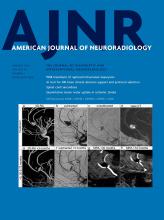Research ArticleNeurointervention
Viz.ai Implementation of Stroke Augmented Intelligence and Communications Platform to Improve Indicators and Outcomes for a Comprehensive Stroke Center and Network
M.E. Figurelle, D.M. Meyer, E.S. Perrinez, D. Paulson, J.S. Pannell, D.R. Santiago-Dieppa, A.A. Khalessi, D.S. Bolar, J. Bykowski and B.C. Meyer
American Journal of Neuroradiology January 2023, 44 (1) 47-53; DOI: https://doi.org/10.3174/ajnr.A7716
M.E. Figurelle
aFrom the University of California, San Diego, San Diego, California
D.M. Meyer
aFrom the University of California, San Diego, San Diego, California
E.S. Perrinez
aFrom the University of California, San Diego, San Diego, California
D. Paulson
aFrom the University of California, San Diego, San Diego, California
J.S. Pannell
aFrom the University of California, San Diego, San Diego, California
D.R. Santiago-Dieppa
aFrom the University of California, San Diego, San Diego, California
A.A. Khalessi
aFrom the University of California, San Diego, San Diego, California
D.S. Bolar
aFrom the University of California, San Diego, San Diego, California
J. Bykowski
aFrom the University of California, San Diego, San Diego, California
B.C. Meyer
aFrom the University of California, San Diego, San Diego, California

References
- 1.↵The National Institute of Neurological Disorders and Stroke rt-PA Stroke Study Group. Tissue plasminogen activator for acute ischemic stroke. N Engl J Med 1995;333:1581–87 doi:10.1056/NEJM199512143332401 pmid:7477192
- 2.↵
- Fransen PS,
- Beumer D,
- Berkhemer OA, et al
- 3.↵
- Powers WJ,
- Rabinstein AA,
- Ackerson T, et al
- 4.↵
- 5.↵
- 6.↵
- 7.↵Target: Stroke Phase III. Introducing Target: Stroke Phase III. https://www.heart.org/en/professional/quality-improvement/target-stroke/introducing-target-stroke-phase-iii. Accessed October 6, 2022
- 8.↵
- 9.↵
- 10.↵
- 11.↵
- 12.↵
- 13.↵
- Aghaebrahim A,
- Streib C,
- Rangaraju S, et al
- 14.↵
- Frei D,
- McGraw C,
- McCarthy K, et al
- 15.↵
- Panezai S,
- Meghpara S,
- Kulhari A, et al
- 16.↵
- 17.↵
- 18.↵
- 19.↵
- Meyer BC,
- Raman R,
- Hemmen T, et al
- 20.↵
- Goyal M,
- Jadhav AP,
- Bonafe A, et al
- 21.↵
- 22.↵
- Kidwell CS,
- Jahan R,
- Gornbein J, et al
- 23.↵
- Murray NM,
- Unberath M,
- Hager GD, et al
- 24.↵
- Mehta BP,
- Leslie-Mazwi TM,
- Chandra RV, et al
- 25.↵
- Lin CB,
- Peterson ED,
- Smith EE, et al
- 26.↵
- Patel MD,
- Rose KM,
- O’Brien EC, et al
- 27.↵
- Al-Kawaz M,
- Primiani C,
- Urrutia V, et al
In this issue
American Journal of Neuroradiology
Vol. 44, Issue 1
1 Jan 2023
Advertisement
M.E. Figurelle, D.M. Meyer, E.S. Perrinez, D. Paulson, J.S. Pannell, D.R. Santiago-Dieppa, A.A. Khalessi, D.S. Bolar, J. Bykowski, B.C. Meyer
Viz.ai Implementation of Stroke Augmented Intelligence and Communications Platform to Improve Indicators and Outcomes for a Comprehensive Stroke Center and Network
American Journal of Neuroradiology Jan 2023, 44 (1) 47-53; DOI: 10.3174/ajnr.A7716
0 Responses
Jump to section
Related Articles
Cited By...
- Workflow improvements from automated large vessel occlusion detection algorithms are dependent on care team engagement
- Acquisition of Prehospital Stroke Severity Scale is associated with shorter door-to-puncture times in patients with prehospital notifications transported directly to a thrombectomy center
- The Impact of Artificial Intelligence on Large Vessel Occlusion Stroke Detection and Management: A Systematic Review Meta-analysis
- The perils and promises of generative artificial intelligence in neurointerventional surgery
This article has not yet been cited by articles in journals that are participating in Crossref Cited-by Linking.
More in this TOC Section
Neurointervention
Similar Articles
Advertisement











